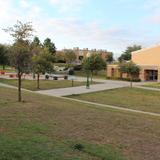- South Plains College provides a quality learning environment. We are a comprehensive, public, open admissions community college that primarily serves a 15-county region comprising the southern portion of the Texas High Plains. We are committed to providing learning opportunities that are high quality, accessible, flexible, and affordable through academic transfer, technical-vocational, continuing education, workforce development and community service programs.
School Highlights
South Plains College serves 11,925 students (44% of students are full-time).
The college's student-teacher ratio of 19:1 is lower than the state community college average of 23:1.
Minority enrollment is 59% of the student body (majority Hispanic), which is less than the state average of 74%.
Quick Facts (2025-26)
- Enrollment: 11,925 students
- In-state tuition: $3,254
- Out-state tuition: $3,446
- Student-teacher ratio: 19:1
- Minority enrollment: 59%
- Source: Integrated Postsecondary Education Data System (IPEDS)
Top Rankings
South Plains College ranks among the top 20% of public schools in Texas for:
School Overview
The teacher population of 627 teachers has stayed relatively flat over five years.
South Plains College
(TX) Community College Avg.
Carnegie Classification
Associate's Colleges: High Transfer-High Traditional
Baccalaureate/Associate's Colleges: Associate's Dominant
Institution Level
At least 2 but less than 4 years
At least 2 but less than 4 years
Institution Control
Public
Public
Total Faculty
627 staff
262 staff
School Calendar
Student Body
The student population of South Plains College has grown by 29% over five years.
The student-teacher ratio of 19:1 has increased from 14:1 over five years.
The South Plains College diversity score of 0.59 is less than the state average of 0.70. The school's diversity has stayed relatively flat over five years.
Total Enrollment
11,925 students
4,931 students
Student-Teacher Ratio
19:1
23:1
# Full-Time Students
5,290 students
909 students
# Part-Time Students
6,635 students
4,022 students
# Enrollment Undergraduate
119 students
403 students
# Full-Time Undergraduate Students
5,290 students
890 students
# Full-Time Graduate Students
n/a
40 students
# Part-Time Undergraduate Students
6,635 students
4,166 students
# Part-Time Graduate Students
n/a
47 students
Total Dormitory Capacity
774 students
252 students
% American Indian/Alaskan
1%
n/a
% Asian
2%
6%
% Hispanic
49%
46%
% Black
6%
13%
% White
41%
26%
% Hawaiian
n/a
n/a
% Two or more races
n/a
3%
% Non Resident races
n/a
2%
% Unknown races
n/a
4%
Diversity Score
0.59
0.70
College Completion Rate (Students who graduate in less than 4 years)
20%
55%
College Completion Rate (Students who graduate in 4 years or more than 4 years)
n/a
34%
Average Graduate Earnings (10 Years)
$36,400
$34,600
Tuition and Acceptance Rate
The public in-state tuition of $3,254 is less than the state average of $3,764. The in-state tuition has declined by 16% over four years.
The public out-state tuition of $3,446 is less than the state average of $6,054. The out-state tuition has declined by 19% over four years.
In-State Tuition Fees
$3,254
$3,764
Out-State Tuition Fees
$3,446
$6,054
% Students Receiving Some Financial Aid
80%
84%
Median Debt for Graduates
$10,973
$10,765
Median Debt for Dropouts
$6,334
$5,500
Acceptance Rate
n/a
84%
Source: 2024 (or latest year available) Integrated Postsecondary Education Data System (IPEDS) , School Administrators
School Notes
- In 1958, the college opened its doors primarily as a two-year academic transfer institution, the first such college in Texas in more than 10 years. South Plains College opened the door to the expansion of community colleges in Texas, arguably the most significant development in Texas higher education of the last half of the twentieth century. Fruitful changes began almost immediately. In 1959, Whiteface Independent School District became a part of the district, which was redesignated the South Plains Junior College District. In the early 1960s, the district developed a clearer notion of community college and rapidly incorporated technical and vocational education, continuing education, and educational counseling and other student support services. South Plains College's main campus is located in Levelland, Texas. Established in 1957 by the residents of Hockley County, South Plains College offers its students a diverse educational program. The program of study on the Levelland Campus spans freshman and sophomore studies for students who plan to eventually earn a bachelor's degree. These classes, offered through the Arts and Sciences Division, parallel those offered by universities and are fully transferable to these schools. First-class technical programs are also available to students who want to obtain specific job skills in one or two years of college and then go right to work in a good-paying job. SPC is recognized as one of the most modern and complete community colleges in Texas. The Levelland Campus encompasses 40 buildings on a 177-acre campus. Attractively landscaped and maintained, the campus features a contemporary architectural design that enhances an excellent learning environment. The college offers degrees and certificates in Arts and Sciences, Health Occupations, Technical Education, Continuing Education, Workforce Development, Internet Courses and Dual Credit Courses. South Plains College is accredited by the Commission on Colleges of the Southern Association of Colleges and Schools to award associate degrees and proficiency certificates. SPC is an approved college recognized by the Texas Higher Education Coordinating Board.
Frequently Asked Questions
How much does South Plains College cost?
South Plains College's tuition is approximately $3,254 for In-State students and $3,446 for Out-State students.
What is South Plains College's ranking?
South Plains College ranks among the top 20% of community college in Texas for: Least expensive tuition and Largest student body.
Recent Articles

The Rise of Technical and Vocational Training in 2025
Explore the 2025 surge in technical and vocational training—enrollment, policy, costs, and why this path is gaining ground for students and parents.

Stackable Credentials: How Community Colleges Advance Careers
Discover how community colleges use stackable credentials to build career pathways, boost earnings, and enable lifelong learning in 2025.

High-Paying Jobs You Can Get with a Community College Degree
Discover top high-paying careers you can launch in 2025 with a community college (associate) degree and high-growth credentials in tech, healthcare and trades.












